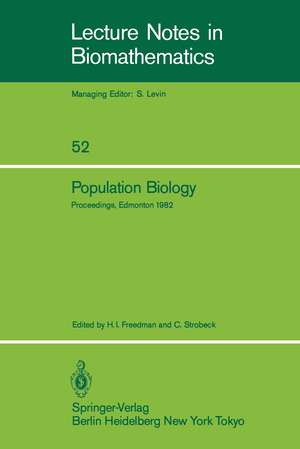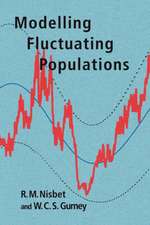Population Biology: Proceedings of the International Conference held at the University of Alberta, Edmonton, Canada, June 22–30, 1982: Lecture Notes in Biomathematics, cartea 52
Editat de H. I. Freedman, C. Strobecken Limba Engleză Paperback – sep 1983
Din seria Lecture Notes in Biomathematics
-
 Preț: 378.54 lei
Preț: 378.54 lei -
 Preț: 380.45 lei
Preț: 380.45 lei -
 Preț: 413.37 lei
Preț: 413.37 lei -
 Preț: 390.63 lei
Preț: 390.63 lei -
 Preț: 396.24 lei
Preț: 396.24 lei -
 Preț: 387.38 lei
Preț: 387.38 lei -
 Preț: 385.08 lei
Preț: 385.08 lei - 5%
 Preț: 366.56 lei
Preț: 366.56 lei -
 Preț: 384.70 lei
Preț: 384.70 lei -
 Preț: 388.13 lei
Preț: 388.13 lei -
 Preț: 394.29 lei
Preț: 394.29 lei - 5%
 Preț: 389.93 lei
Preț: 389.93 lei - 5%
 Preț: 370.74 lei
Preț: 370.74 lei -
 Preț: 384.86 lei
Preț: 384.86 lei -
 Preț: 387.96 lei
Preț: 387.96 lei -
 Preț: 404.29 lei
Preț: 404.29 lei -
 Preț: 391.61 lei
Preț: 391.61 lei -
 Preț: 384.48 lei
Preț: 384.48 lei -
 Preț: 384.48 lei
Preț: 384.48 lei -
 Preț: 383.71 lei
Preț: 383.71 lei -
 Preț: 379.68 lei
Preț: 379.68 lei -
 Preț: 384.09 lei
Preț: 384.09 lei -
 Preț: 405.66 lei
Preț: 405.66 lei -
 Preț: 379.48 lei
Preț: 379.48 lei -
 Preț: 400.65 lei
Preț: 400.65 lei -
 Preț: 385.25 lei
Preț: 385.25 lei -
 Preț: 390.25 lei
Preț: 390.25 lei -
 Preț: 395.47 lei
Preț: 395.47 lei -
 Preț: 378.71 lei
Preț: 378.71 lei -
 Preț: 382.95 lei
Preț: 382.95 lei - 15%
 Preț: 578.01 lei
Preț: 578.01 lei -
 Preț: 380.84 lei
Preț: 380.84 lei -
 Preț: 405.66 lei
Preț: 405.66 lei -
 Preț: 399.12 lei
Preț: 399.12 lei -
 Preț: 410.66 lei
Preț: 410.66 lei -
 Preț: 385.62 lei
Preț: 385.62 lei - 5%
 Preț: 371.10 lei
Preț: 371.10 lei -
 Preț: 378.71 lei
Preț: 378.71 lei -
 Preț: 386.99 lei
Preț: 386.99 lei -
 Preț: 401.61 lei
Preț: 401.61 lei -
 Preț: 350.30 lei
Preț: 350.30 lei -
 Preț: 383.33 lei
Preț: 383.33 lei -
 Preț: 408.54 lei
Preț: 408.54 lei -
 Preț: 398.53 lei
Preț: 398.53 lei -
 Preț: 399.67 lei
Preț: 399.67 lei -
 Preț: 391.79 lei
Preț: 391.79 lei -
 Preț: 384.86 lei
Preț: 384.86 lei -
 Preț: 392.60 lei
Preț: 392.60 lei -
 Preț: 406.05 lei
Preț: 406.05 lei
Preț: 401.61 lei
Nou
Puncte Express: 602
Preț estimativ în valută:
76.86€ • 83.46$ • 64.56£
76.86€ • 83.46$ • 64.56£
Carte tipărită la comandă
Livrare economică 22 aprilie-06 mai
Preluare comenzi: 021 569.72.76
Specificații
ISBN-13: 9783540126775
ISBN-10: 3540126775
Pagini: 464
Ilustrații: XVIII, 444 p.
Dimensiuni: 170 x 244 x 24 mm
Greutate: 0.74 kg
Ediția:1983
Editura: Springer Berlin, Heidelberg
Colecția Springer
Seria Lecture Notes in Biomathematics
Locul publicării:Berlin, Heidelberg, Germany
ISBN-10: 3540126775
Pagini: 464
Ilustrații: XVIII, 444 p.
Dimensiuni: 170 x 244 x 24 mm
Greutate: 0.74 kg
Ediția:1983
Editura: Springer Berlin, Heidelberg
Colecția Springer
Seria Lecture Notes in Biomathematics
Locul publicării:Berlin, Heidelberg, Germany
Public țintă
ResearchCuprins
I Population Genetics.- The Use of Coefficients of Identity to Study Random Drift.- Instability and Repulsivity of the Fixation States in Biallelic Selection Models.- Microscopic Clustering of Population Processes.- Models for Peripheral Populations: The Role of Immigration.- A Mathematical Analysis of the Chitty Hypothesis.- An Haploid Model for Genotype-Dependent Population Diffusion.- Further Models of Selection with Antagonistic Pleiotropy.- Algebraic Methods in Genetics.- II Life History Strategies.- The Evolution of Life Histories Under Pleiotropic Constraints and K-Selection.- On the r-K Tradeoff in Density Dependent Selection.- A Test of Ideas About the Evolution of Efficiencies and Strategies of Resource Use.- Compensatory Strategies of Energy Investment in Uncertain Environments.- A Geometric Model for Optimal Life History.- Necessary Conditions for an Invasion Proof Strategy.- The Evolution of Stable Strategies.- III Population Growth.- Forecasting the Human Population.- Persistence in Uncertain Environments.- Formulating Population Models with Differential Aging.- Population Modelling by Higher Order Differential Equations.- Concerning the Time-Dependence of Population Vital Rates.- Extinction Probabilities in Stochastic Age-Structured Models of Population Growth.- The Systematic Formulation of Delay-Differential Models of Age or Size Structured Populations.- Lotka Distribution for a Finite Mixture of Human Populations I.- A Problem in Nonlinear Age Dependent Population Diffusion.- IV Competitive Systems.- Coexistence of Competitors in a Stochastic Environment: The Storage Effect.- Invited Guest Lecture: Models of Competition for a Single Resource.- Competitive Predator-Prey Systems and Coexistence.- Coexistence of Many Competing Species.- Competition and Age-Structure.- Selection of Molecular Species by Competition for a Common Source.- An Analysis of Competition Between The Larvae of a Deposit-Feeding and a Filter-Feeding Species of Chironomid (Diptera), Using a Mechanistic Model.- V predator-Prey Systems.- Invited Guest Lecture: The Dynamics of Host-Parasitoid Interactions with Heterogeneity Host Density Dependence and Variable Sex Ratios.- Some Applications of Coherent State Representation to Nonlinear Bio-Oscillators.- Mathematical Analysis of Some Resource-PreyPredator Models: Application to a NPZ Microcosm Model.- Resonance in Prey-Predator Systems.- A Mathematical Model of Population Regulation in Cyclic Mammals.- Monotone Schemes for Three Species Prey-Predator Reaction-Diffusion.- Some Age-Structure Effects in Predator-Prey Models.- A Model Predator-Prey System with Mutual Interference and Time Delay.- Oscillations in Prey-Predator Volterra Models.- VI Community Ecology.- Coevolution.- A Coexistence Model for N-Species Using Nearest Neighbour Interaction and the Role of Diffusion.- Periodic Lotka-Volterra Systems and Time Sharing of Ecological Niches.- Nonobligate and Obligate Models of Mutualism.- Stability of Community Interaction Matrices.- Biomass Flow, Structure and Stability of Model Ecological Systems.- Is Dynamical Systems Theory the Best Way to Understand Ecosystem Stability?.- Stability in Compartmental Models.- VII Resource Management.- Invited Guest Lecture: Search Theory in Ecology and Resource Management.- Models of Pheromone Release for Pest Control in which Males Attract Females.- Age- and Size-Specific Models in the Dungeness Crab Fishery.- Harvesting Under Small Demographic Uncertainty.- Resource Recovery Time: Just How Destabilizing Is It?.- VIII Epidemology and Immunology.- Influence of Infectious Disease on the Growth of a Population with Three Genotypes.- Interaction of Antitumor Cells: Competition and Interference.- A Model for Infection.- A Cyclic Epidemic Model with Temporary Immunity and Vital Dynamics.















